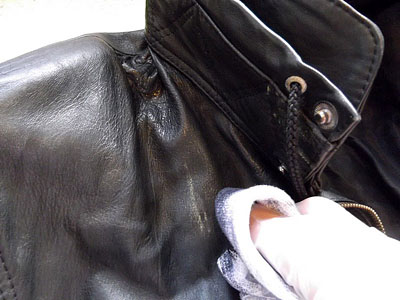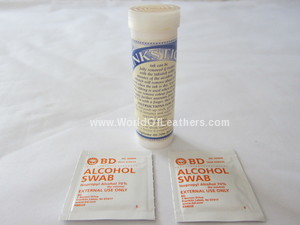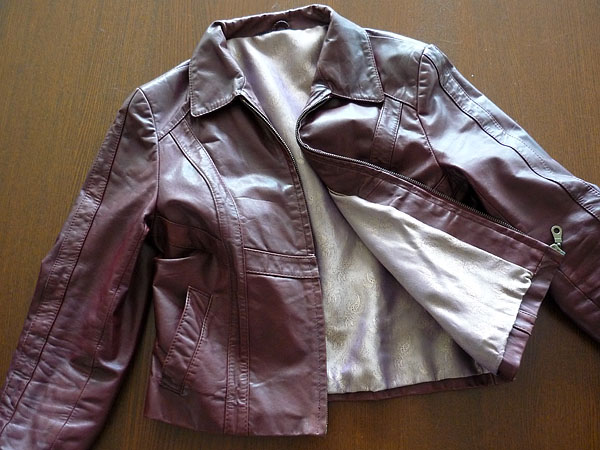Cleaning leather coats can be a daunting task. Leather is a hardwearing and long-lasting material but does not respond well to getting wet or having liquids applied to it. To keep your leather clothing looking like new you must follow some careful care instructions.
 Many leather garments have a silky interior lining, and while the outer layer of leather can be cleaned with a damp cloth then polished with dubbin or some other leather-specific cleaner, if you want to stop the interior smelling smoky or sweaty you will need to use the right kind of cleaners.
Many leather garments have a silky interior lining, and while the outer layer of leather can be cleaned with a damp cloth then polished with dubbin or some other leather-specific cleaner, if you want to stop the interior smelling smoky or sweaty you will need to use the right kind of cleaners.
If you feel you are not up to the task of taking care of your leather coat then you can always take it to a professional cleaner. However, cleaning leather coats at home is possible.
Cleaning the Outside
General Cleaning
Always check the inner lining or the inside of the inner side pocket for the manufacturer’s care labels on cleaning instructions and the actual type of leather used to make the coat or jacket. The instruction labels often instruct you to bring your leather apparel to a professional cleaner that specializes in leather apparels because the many different types of leather used in manufacturing the coat/jacket prevent any one single cleaning method at home to be 100% effective 100% of the time but it is rather expensive to do this on a regular basis.
Many leather care websites dish out the standard advice that you should always test out any leather cleaning solution prior to usage on an inconspicuous part of your leather apparel without actually specifying where to test it out! I recommend turning the cuff inside out and testing it on the cuff surface.
If the leather changes colour, darkens or lightens even after the liquid has dried, then it should not be used as any changes will likely be permanent. In any event, before applying any liquids or leather cleaning solutions including plain water, it is important to test it first by applying a few drops of plain water onto the inside of the cuff. If it formed beads or droplets without being absorbed into the leather after a few minutes, you will know straightway that it is protected (pigmented/finished) leather and it is safe to proceed with caution. But if it is absorbed immediately into the leather, then you have to proceed with extreme caution. It is probably safer to just use only a clean soft cloth slightly damped with plain water to do the cleaning especially with pure aniline dyed (naked) leathers.
Cleaning Methods
A mild soapy solution can be used to clean the outside of your coat which is actually the preferred method. Use a few drops of a PH. balanced unscented liquid soap, baby shampoo or pet shampoo to create the soapy solution. Wipe down the exterior of the jacket with a damp sponge or cloth soaked in warm, soapy water, and then dry the coat with a soft cloth. You should only clean the exterior of the coat when it is actually dirty. Typically, this would mean cleaning the outside of your coat once a year.
Leather Wipes have been recommended by other leather care websites. I personally feel that the only tangible benefits are the ease of use and convenience. Its effectiveness is somewhat doubtful because if you pause and think about it, how is it possible that leather wipes can claim to “clean, condition & protect” when cleaning requires you to remove dirt/stains and good leather conditioners are about adding the right oils in?
Good quality shampoos and conditioners are sold separately as individual products because they do a much better job that an All in One product, likewise proper cleaning and conditioning of leather cannot be done in a single action by a single product. Moreover, they are expensive, non-recyclable and environment unfriendly.
Olive Oil has been recommended by other leather care websites to clean and condition leather apparels. The idea is to dab a soft clean cloth with a generous amount of olive oil and rub it onto the dirty areas to remove dirt and stains by lifting it. I am unable to recommend this method to clean or condition leather clothing because there is a good chance you will damage your leather outfit if the Olive Oil soaks into the leather and create a permanent stain that would be difficult if not almost impossible to remove.
White vinegar has also been recommended by the same leather care websites to clean leather coats/jackets using the same cleaning process as the Olive Oil method after which, the leather is conditioned in a final process where equal amounts of olive oil and white vinegar are mixed together and this liquid mixture is then applied onto the leather with a soft clean cloth to condition it. Again, I am hesitant to use White Vinegar solely or in combination with Olive Oil on leather clothing for the earlier reason mentioned above.
Washing Machine wash has been recommended by these same leather care websites again to clean your leather coat/jacket. Now, adding 2 tablespoons of laundry detergent, setting the shortest delicate wash cycle, using cold water at the lowest load setting, turning your leather garment inside out and zipping/buttoning it up does not mean you will avoid or even reduce your chances of permanently damaging your garment!
In fact, it is simply not worth taking the risk just to ensure that you achieve an absolutely clean and nice smelling interior. The thread stitching can come undone; the lining material can form unsightly and uneven clumps after having been soaked through with water. Because you have absolutely no idea how the leather was tanned, the leather can shrink, get stained or discolor with unsightly patches.
To sum up, all the above leather cleaning methods at home can only be used on a limited range of leathers such as protected (pigmented/finished) leathers. Even then, results may vary and there is every possibility of causing damage to the leather clothing. Please note Suede and Nubuck leathers must never be clean using any of the above methods and they also cannot be conditioned with any oils or other types of liquid conditioners.
Post Cleaning Conditioning
After wiping down the outside of the coat, hang it up and allow it to air dry. Once the coat is dry, apply some leather conditioner to it sparingly. The conditioner will keep the leather soft and flexible. This is the most important part of cleaning leather coats. If you neglect this then the coat may become stiff and the leather could crack. Best to apply conditioner even if you plan to put the coat into storage until next winter.
Stains Removal
Time is of the essence and the longer the stain stays on the leather garment, the harder to remove it successfully. However, you may have no choice but to bring it to the professional leather cleaners and not risk a D.I.Y stain removal job if the stains are serious enough to shake your confidence in removing them on your own at home. The ultimate goal is to remove stains completely without damaging the leather and some leathers are simply too fragile to be subjected to any stain removal methods.
 Ink Stains can be completely removed if treated within minutes of the accident by the use of professional leather stain removal products such as the Gliptone Ink stick (shown here) which I have used regularly with much success. Once the ink is dry, it will be more difficult to remove the ink stain completely even with the professional leather stain removal product.
Ink Stains can be completely removed if treated within minutes of the accident by the use of professional leather stain removal products such as the Gliptone Ink stick (shown here) which I have used regularly with much success. Once the ink is dry, it will be more difficult to remove the ink stain completely even with the professional leather stain removal product.
Take note! If the ink stain can still be removed, there is also the chance of the color being removed from the leather as well because the ink stain had already set in. You probably will not be in possession of a product like the Gliptone Ink stick so we need to look at other home based D.I.Y solutions.
I have use alcohol swabs and cotton buds dipped in Isopropyl Alcohol (rubbing alcohol) to remove ink stains but this works best only if it is protected (pigmented/finished) leather. You need to apply just the right amount of pressure to remove the ink stain without removing the base color and then use a leather conditioner to recondition it.
Another method is to use a white colored pencil eraser to avoid color transfer and apply just enough rubbing pressure to remove the ink stain without stripping the leather base color. You can try a pen ink eraser too but you need to take extra care to ensure the color does not transfer over during the rubbing process which must be done gently.
Some other methods recommended by many leather care websites include the use of olive oil, hand or face moisturizers or even hairsprays. However, I would not recommend these methods as there is a likelihood the oils may loosen the ink but spread the ink stains and set it even deeper into the leather.
Grease stains are best removed by sprinkling talcum powder onto the stain and gently rubbing it into the leather grain in order to ensure maximum absorption as soon as possible and then wait for several hours before gently brushing it off with a clean soft microfiber cloth or soft bristle toothbrush.
Your success in removing grease stains is largely dependent on whether the leather has a protective finish or is unprotected leather. If it is the latter, the grease will soak in and probably be almost impossible to remove completely. Treating the stain promptly is your best bet for any chance of removing the stain and you may be able to remove most of it or at least lighten it with the method above.
If the leather has a protective finish on it, a water-based leather cleaner such as the one shown here  should remove the stains and always strictly follow the instructions on the cleaner for best results. After cleaning, it may be best to apply a stain guard to the leather surface to prevent future stains, allow for easier cleaning up and stain removal.
should remove the stains and always strictly follow the instructions on the cleaner for best results. After cleaning, it may be best to apply a stain guard to the leather surface to prevent future stains, allow for easier cleaning up and stain removal.
Cleaning The Coat Liner
One of the hardest parts of cleaning coats is figuring out what to do with the liner. The coat liner may spend some time directly exposed to bare skin, especially in the area around the arms, and will pick up sweat as well as dirt from the atmosphere.
The first step to cleaning the coat liner is to hang it up or spread it out on the floor, inside out, so that you can clean it with a vacuum cleaner. This will remove smoke, dust and dirt. Once you have vacuum cleaned the liner, let it air out for a while and then inspect it closely. If there are lingering odors, spray the liner with Febreeze or some other form of clothes freshener. But be extra careful to avoid spraying the leather parts!
 If a spray of freshener does not help to clean the coat, it may need a more intensive cleaning with detergent. Mix some into water with some baking soda, and stir until suds form. Dip a sponge into the water, then wring it out so that it is just slightly damp. Do not saturate the sponge, because if the liner gets too wet the water could seep through to the leather and damage it.
If a spray of freshener does not help to clean the coat, it may need a more intensive cleaning with detergent. Mix some into water with some baking soda, and stir until suds form. Dip a sponge into the water, then wring it out so that it is just slightly damp. Do not saturate the sponge, because if the liner gets too wet the water could seep through to the leather and damage it.
Wipe the liner down with the sponge, then wipe it again with a soft dry cloth to soak up any excess water. Work slowly and methodically across the entire garment until the liner is clean, then hang the coat up to allow it to air dry.
What Not to Do
Do not fold your jacket – always hang it up so that creases do not form. If your jacket already has some creases in it, lay the jacket out on a flat surface with a thick piece of paper over the top of it. Use a warm (not hot) iron to even out the crease. If the crease is very stubborn, hang the jacket up in the bathroom and run a hot shower. The steam from the shower will help to remove any wrinkles.
Do not use detergents directly on the leather without a patch test. Only apply chemical cleaning products to the leather if they are expressly advertised as being suitable for this purpose. If you have tried home cleaning your coat and the stains still persist, consider taking your jacket to a professional cleaning service. They usually have more experience with cleaning delicate garments and more likely to remove the stains effectively.